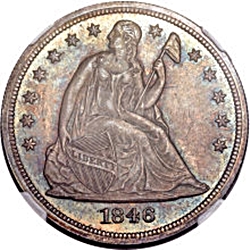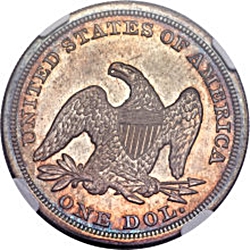 |
1846 
 |
 |
|
| |||||||||||||||||||||
1846 Die Marriages
The following table summarizes the known die marriages for 1846:
Click the links below to view the details of the die marriages.
Die Marriage |
Rarity |
Obverse Die |
Reverse Die |
Estimated Survivors |
| OC-1 | R1 | 1 | A | 2300 |
| OC-2 | R2 | 1 | B | 1200 |
| OC-P1 | R6- | P1 | 1840 PA | 25 |
| OC-P2 | - | P2 | 1840 PA? | Unknown |
3 die marriages have been positively identified, with a 4th possible. OC-1 and OC-2 are the only known business strike die marriages. They share the same obverse die. Neither marriage is particularly rare. Examples of OC-1 are normally seen with light clash marks. The clashing is most visible in the field under Miss Liberty’s right arm. Examples are known with a single clash and with two clashes. We’ve seen a few examples of OC-1 with perfect dies, no signs of clashing, but this die state seems to be scarce or rare. Beware of mistaking middle to late die state examples as the rarer perfect state. The obverse die was polished midway in its first pairing, removing most evidence of the die clashing. By the time this was done the reverse die had begun to crack. Examples of OC-2 show little evidence of clashing, since they were struck after obverse 1 was polished.
Apparently, none of the business strike dies were used for proofs, although one example of the OC-1 die marriage exists in an NGC PR62 holder (see additional comments below). References, including Bowers (reference 4) and Breen (reference 7) have frequently claimed that two different proof die marriages were struck, using two different obverse dies, each paired with the reverse used for all proofs in the 1840’s (the Breen reference is silent on the reverse pairing). The frequently seen proof die pairing exhibits a strongly repunched date. The original date was punched far too low, nearly half the height of the date below the proper position. The date was then partially effaced and repunched in the proper position, making a very interesting variety. We’ve designated this die marriage as OC-P1, and included it as one of our Top-30 varieties. We have not been able to confirm the existence of the second proof die marriage, but have left a place-holder, designating it OC-P2.
The OC-P2 variety, if it exists, is extremely rare. Breen lists 5 examples. The only one that we could trace, the coin from the World’s Greatest Collection, is an example of the OC-P1 die pair, not a second die marriage. The only record of a second die marriage that we found in the Heritage archives is a sale in January, 2007 (and again in February, 2016), of an NGC PR62 example. We examined this coin prior to the 2016 sale. It’s an example of our OC-1 die marriage, in a die state that puts its issue at the time the obverse die was polished to remove clash marks and cover die cracks. The reverse exhibits very heavy die cracks, making it unlikely that this coin is truly a proof. More likely it’s one of the first strikes after the obverse die was polished. No provenance was listed for the coin when it was auctioned by Heritage, but it’s likely one of the examples listed by Breen. We’ve also seen references to the coin in the National Collection as being a normal date example (Bowers, reference 4). We hope in the future to have a chance to examine this coin to confirm its attribution. For now, our belief is that OC-P2 probably doesn’t exist.
1846 Business Strike Emission Sequence
In its early state the 1846 business strike obverse die exhibited light die polish lines extending
from the rim below the date into the field. These lines were removed when the die was polished mid-way in the period
of OC-1 coinage. They aren’t found on the OC-2 die pairing, so the order is clear.
Emission Order |
Die Marriage |
Comments |
| 1 | OC-1 | |
| 2 | OC-2 | Die polish lines under date are gone |
1846 Proof Emission Sequence
As noted previously we’ve had no opportunity to examine an example of OC-P2, or even to confirm
its existence, so this emission sequence is purely arbitrary.
Emission Order |
Die Marriage |
Comments |
| 1 | OC-P1 | |
| 2 | OC-P2 |
1846 Quick Finder Chart
With 3 different die marriages confirmed, and only two business strike die marriages, attribution should be
straightforward. However, early die states can be difficult to attribute, particularly if only a picture
is available. The reverse dies have very few major markers until the dies crack in middle to late states.
Identifying early states will require a relatively high-grade coin, at least VF20, and a high-magnification
glass or stereo microscope.
Die Marriage |
Obv. Die |
Rev. Die |
Right Base |
Keys to Identification |
| OC-1 | 1 | A | L QTR | Obverse: A die dot on Miss Liberty’s breast just above the gown line, just left of the V of her gown. A die line near the top of shield recess #4, just below the E in LIBERTY. Reverse: A small lump connects the upper berry to the eagle's leg. Middle to late states exhibit a die crack extending from the rim above D1 across the top of STATES OF back to the rim above A2. |
| OC-2 | 1 | B | L QTR | Obverse: A die dot on Miss Liberty’s breast just above the gown line, just left of the V of her gown. A die line near the top of shield recess #4, just below the E in LIBERTY. Reverse: Early die states - no notable markers. Middle to late die states exhibit a die crack extending from the rim below U across the top of UNITED STATES OF AMERICA. |
| OC-P1 | P1 | 1840 PA | LE | Obverse: Boldly repunched date. Reverse: Defects on A3. |
| OC-P2 | P2 | 1840 PA? | Unknown | Obverse: Unknown. Reverse: Defects on A3. |
| Photo credits:
Obverse and Reverse full photos: NGC MS65+, finest known, ex. Green/Newman, from the Heritage archives. |
